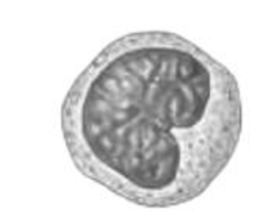
Concept explainers
Introduction: White blood cells (WBCs) are immune cells that play a major role in the body’s defense mechanism. WBCs, also known as leukocytes, protect the body from foreign antigens and infectious diseases. The five types of white blood cells are neutrophils, basophils, eosinophils, lymphocytes, and monocytes.
Answer to Problem 1CRQ
Pictorial representation: The given figure is labeled as a monocyte.

Fig.1: Monocyte
Explanation of Solution
In the immune system, monocytes are one of the crucial white blood cells. Monocytes are amoeboid in structure and possess non-granulated cytoplasm; hence, they are termed as agranulocytes. They differentiate into macrophages. If an infection or tissue damage happens, the monocytes leave the blood and reach the affected area (tissue) and undergo a sequence of changes to become macrophages. They are also involved in the tissue repair mechanism.
Want to see more full solutions like this?
Chapter 17 Solutions
EBK VISUAL ANATOMY & PHYSIOLOGY
- In one paragraph show how atoms and they're structure are related to the structure of dna and proteins. Talk about what atoms are. what they're made of, why chemical bonding is important to DNA?arrow_forwardWhat are the structure and properties of atoms and chemical bonds (especially how they relate to DNA and proteins).arrow_forwardThe Sentinel Cell: Nature’s Answer to Cancer?arrow_forward
- Molecular Biology Question You are working to characterize a novel protein in mice. Analysis shows that high levels of the primary transcript that codes for this protein are found in tissue from the brain, muscle, liver, and pancreas. However, an antibody that recognizes the C-terminal portion of the protein indicates that the protein is present in brain, muscle, and liver, but not in the pancreas. What is the most likely explanation for this result?arrow_forwardMolecular Biology Explain/discuss how “slow stop” and “quick/fast stop” mutants wereused to identify different protein involved in DNA replication in E. coli.arrow_forwardMolecular Biology Question A gene that codes for a protein was removed from a eukaryotic cell and inserted into a prokaryotic cell. Although the gene was successfully transcribed and translated, it produced a different protein than it produced in the eukaryotic cell. What is the most likely explanation?arrow_forward
- Molecular Biology LIST three characteristics of origins of replicationarrow_forwardMolecular Biology Question Please help. Thank you For E coli DNA polymerase III, give the structure and function of the b-clamp sub-complex. Describe how the structure of this sub-complex is important for it’s function.arrow_forwardMolecular Biology LIST three characteristics of DNA Polymerasesarrow_forward
 Human Physiology: From Cells to Systems (MindTap ...BiologyISBN:9781285866932Author:Lauralee SherwoodPublisher:Cengage Learning
Human Physiology: From Cells to Systems (MindTap ...BiologyISBN:9781285866932Author:Lauralee SherwoodPublisher:Cengage Learning





